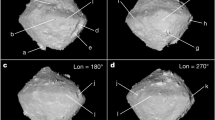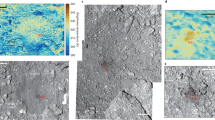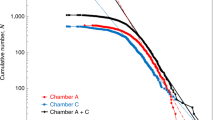Abstract
C-type asteroids are among the most pristine objects in the Solar System, but little is known about their interior structure and surface properties. Telescopic thermal infrared observations have so far been interpreted in terms of a regolith-covered surface with low thermal conductivity and particle sizes in the centimetre range. This includes observations of C-type asteroid (162173) Ryugu1,2,3. However, on arrival of the Hayabusa2 spacecraft at Ryugu, a regolith cover of sand- to pebble-sized particles was found to be absent4,5 (R.J. et al., manuscript in preparation). Rather, the surface is largely covered by cobbles and boulders, seemingly incompatible with the remote-sensing infrared observations. Here we report on in situ thermal infrared observations of a boulder on the C-type asteroid Ryugu. We found that the boulder’s thermal inertia was much lower than anticipated based on laboratory measurements of meteorites, and that a surface covered by such low-conductivity boulders would be consistent with remote-sensing observations. Our results furthermore indicate high boulder porosities as well as a low tensile strength in the few hundred kilopascal range. The predicted low tensile strength confirms the suspected observational bias6 in our meteorite collections, as such asteroidal material would be too frail to survive atmospheric entry7.
This is a preview of subscription content, access via your institution
Access options
Access Nature and 54 other Nature Portfolio journals
Get Nature+, our best-value online-access subscription
$29.99 / 30 days
cancel any time
Subscribe to this journal
Receive 12 digital issues and online access to articles
$119.00 per year
only $9.92 per issue
Buy this article
- Purchase on Springer Link
- Instant access to full article PDF
Prices may be subject to local taxes which are calculated during checkout




Similar content being viewed by others
Data availability
The data that support the plots within this paper and other findings of this study are available from the corresponding author upon reasonable request.
References
Wada, K. et al. Asteroid Ryugu before the Hayabusa2 encounter. Prog. Earth Planet. Sci. 5, 82 (2018).
Gundlach, B. & Blum, J. A new method to determine the grain size of planetary regolith. Icarus 223, 479–492 (2013).
Sakatani, N. et al. Thermal conductivity model for powdered materials under vacuum based on experimental studies. AIP Adv. 7, 015310 (2017).
Sugita, S. et al. The geomorphology, color, and thermal properties of Ryugu: implications for parent-body processes. Science 364, eaaw0422 (2019).
Flynn, G. J., Consolmagno, G. J., Brown, P. & Macke, R. J. Physical properties of the stone meteorites: implications for the properties of their parent bodies. Geochemistry 78, 269–298 (2018).
Popova, O. et al. Very low strengths of interplanetary meteoroids and small asteroids. Meteorit. Planet. Sci. 46, 1525–1550 (2011).
Watanabe, S. et al. Hayabusa2 mission overview. Space Sci. Rev. 208, 3–16 (2017).
Ho, T. M. et al. MASCOT—The Mobile Asteroid Surface Scout onboard the Hayabusa2 mission. Space Sci. Rev. 208, 339–374 (2017).
Grott, M. et al. The MASCOT radiometer MARA for the Hayabusa 2 mission. Space Sci. Rev. 208, 413–431 (2017).
Moskovitz, N. A. et al. Rotational characterization of Hayabusa II target asteroid (162173) 1999 JU3. Icarus 224, 24–31 (2013).
King, T. V. V. & King, E. A. Grain size and petrography of C2 and C3 carbonaceous chondrites. Meteoritics 13, 47–72 (1978).
Brown, P. G. et al. The fall, recovery, orbit, and composition of the Tagish Lake meteorite: a new type of carbonaceous chondrite. Science 290, 320–325 (2000).
Delbo, M. et al. Thermal fatigue as the origin of regolith on small asteroids. Nature 508, 233–236 (2014).
Hamm, M., Senshu, H. & Grott, M. Latitudinal dependence of asteroid regolith formation by thermal fatigue. Icarus 319, 308–311 (2018).
Molaro, J. L., Byrne, S. & Le, J.-L. Thermally induced stresses in boulders on airless body surfaces, and implications for rock breakdown. Icarus 294, 247–261 (2017).
Krause, M., Blum, J., Skorov, Yu. V. & Trieloff, M. Thermal conductivity measurements of porous dust aggregates: I. Technique, model and first results. Icarus 214, 286–296 (2011).
Henke, S., Gail, H.-P. & Trieloff, M. Thermal evolution and sintering of chondritic planetesimals III. Modelling the heat conductivity of porous chondrite material. Astron. Astrophys. 589, A41 (2016).
Tonui, E. et al. Petrographic, chemical and spectroscopic evidence for thermal metamorphism in carbonaceous chondrites I: CI and CM chondrites. Geochim. Cosmochim. Acta 126, 284–306 (2014).
Ostrowski, D. & Bryson, K. The physical properties of meteorites. Planet. Space Sci. 165, 148–178 (2019).
DellaGiustina, D. N. Properties of rubble-pile asteroid (101955) Bennu from OSIRIS-REx imaging and thermal analysis. Nat. Astron. 3, 341–351 (2019).
Delbo, M., dell’Oro, A., Harris, A. W., Mottola, S. & Mueller, M. Thermal inertia of near-Earth asteroids and implications for the magnitude of the Yarkovsky effect. Icarus 190, 236–249 (2007).
Spohn, T. et al. Thermal and mechanical properties of the near-surface layers of comet 67P/Churyumov-Gerasimenko. Science 349, aab0464 (2015).
Groussin, O. et al. The temperature, thermal inertia, roughness and color of the nuclei of comets 103P/Hartley 2 and 9P/Tempel 1. Icarus 222, 580–594 (2013).
Davidsson, B. J. R., Gutiérrez, P. J. & Rickmann, H. Physical properties of morphological units on comet 9P/Tempel 1 derived from near-IR Deep Impact spectra. Icarus 201, 335–357 (2009).
Fujiwara, A. et al. The rubble-pile asteroid Itokawa as observed by Hayabusa. Science 312, 1330–1334 (2006).
Müller, T. G., Hasegawa, S. & Usui, F. (25143) Itokawa: the power of radiometric techniques for the interpretation of remote thermal observations in the light of the Hayabusa rendezvous results. Publ. Astron. Soc. Jpn 66, 52 (2014).
Yang, R. Y., Zou, R. P. & Yu, A. B. Computer simulation of the packing of fine particles. Phys. Rev. E 62, 3900–3908 (2000).
Neumann, W., Breuer, D. & Spohn, T. Modelling of compaction in planetesimals. Astron. Astrophys. 567, A120 (2014).
Neumann, W., Breuer, D. & Spohn, T. Modelling the internal structure of Ceres: coupling of accretion with compaction by creep and implications for the water-rock differentiation. Astron. Astrophys. 584, A117 (2015).
Hamm, M., Grott, M., Kührt, E., Pelivan, I. & Knollenberg, J. A method to derive surface thermophysical properties of asteroid (162173) Ryugu (1999JU3) from in-situ surface brightness temperature measurements. Planet. Space Sci. 159, 1–10 (2018).
Spencer, J. R., Lebofsky, L. A. & Sykes, M. V. Systematic biases in radiometric diameter determinations. Icarus 78, 337–354 (1989).
Christensen, P. R. et al. The Thermal Emission Imaging System (THEMIS) for the Mars 2001 Odyssey mission. Space Sci. Rev. 110, 85–130 (2004).
Kuehrt, E., Giese, B., Keller, H. U. & Ksanfomality, L. V. Interpretation of the KRFM-infrared measurements on Phobos. Icarus 96, 213–218 (1992).
Giese, B. & Kührt, E. Theoretical interpretation of infrared measurements at Deimos in the framework of crater radiation. Icarus 88, 372–379 (1990).
Macke, R. J., Consolmagno, G. J. & Britt, D. T. Density, porosity, and magnetic susceptibility of carbonaceous chondrites. Meteorit. Planet. Sci. 46, 1842–1862 (2011).
Digby, P. J. The effective elastic moduli of porous granular rocks. J. Appl. Mech. 48, 803–808 (1981).
Scholz, C. H. The Mechanics of Earthquakes and Faulting 2nd edn (Cambridge Univ. Press, 2002).
Ibrahim, M. I. The Elastic Properties of Carbonaceous Chondrites. MSc Thesis, Univ. Calgary (2012); https://doi.org/10.11575/PRISM/28122.
Jones, S. F. Elastic Wave Velocity, Porosity, and Pore Geometry of Ordinary Chondrites and Artificially Shocked Samples. MSc Thesis, Univ. Calgary (2009); https://doi.org/10.11575/PRISM/22027.
Acknowledgements
The MASCOT lander on the Hayabusa2 Mission of JAXA is a DLR/CNES cooperation. MASCOT MARA has been developed and built under the leadership of the DLR Institute of Planetary Research with contracted contributions from the Institute of Photonic Technology. The Hayabusa2 Mission is operated by JAXA. K.O. acknowledges funding by the JSPS Core-to-Core Program ‘International Network of Planetary Sciences.’ A.H. acknowledges funding by STFC under grant no. ST/S001271/1. P.M. acknowledges funding support from the French space agency CNES as well as from Academies of Excellence: Complex systems and Space, environment, risk, and resilience, part of the IDEX JEDI of the Université Côte d’Azur.
Author information
Authors and Affiliations
Contributions
M.G. coordinated and wrote the paper. J.K. and M.G. evaluated the instrument calibration. M.H., K.O., S.M., J.-B.V., M.S. and I.P. computed illumination and thermal models. N. Schmitz, S.E.S., A.K. and F.T. contributed to camera development. K.A.O. and K.D.M. localized the MARA FoV in camera images. W.N., P.M., S. Tachibana, J.B., M.D. and M.K. provided the discussion on material parameters. H.S., T.O., E.K., J.B., H.Y., R.J., N.M., C.P., L.D., N. Sakatani, S. Tanaka, T.A. and S.S. added to the science discussion. J.H. and A.M. contributed to the radiometer development. C.K., T.-M.H. and A.M.-S. contributed to data acquisition. A.H. contributed to instrument characterization. All authors have read and approved the final manuscript.
Corresponding author
Ethics declarations
The authors declare no competing interests.
Additional information
Peer review information: Nature Astronomy thanks Joshua Emery and the other, anonymous, reviewer(s) for their contribution to the peer review of this work.
Publisher’s note: Springer Nature remains neutral with regard to jurisdictional claims in published maps and institutional affiliations.
Supplementary information
Rights and permissions
About this article
Cite this article
Grott, M., Knollenberg, J., Hamm, M. et al. Low thermal conductivity boulder with high porosity identified on C-type asteroid (162173) Ryugu. Nat Astron 3, 971–976 (2019). https://doi.org/10.1038/s41550-019-0832-x
Received:
Accepted:
Published:
Issue Date:
DOI: https://doi.org/10.1038/s41550-019-0832-x
This article is cited by
-
A newly revised estimation of bulk densities and examination of the shape of individual Ryugu grains
Earth, Planets and Space (2023)
-
MASCOT’s in situ analysis of asteroid Ryugu in the context of regolith samples and remote sensing data returned by Hayabusa2
Earth, Planets and Space (2023)
-
Environmental assessment in the prelaunch phase of Hayabusa2 for safety declaration of returned samples from the asteroid (162173) Ryugu: background monitoring and risk management during development of the sampler system
Earth, Planets and Space (2022)
-
Fine-grained regolith loss on sub-km asteroids
Nature Astronomy (2022)
-
Alignment of fractures on Bennu’s boulders indicative of rapid asteroid surface evolution
Nature Geoscience (2022)



